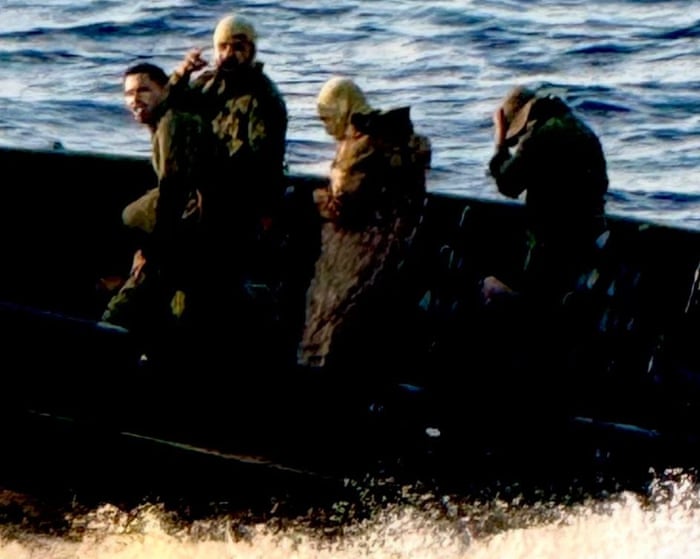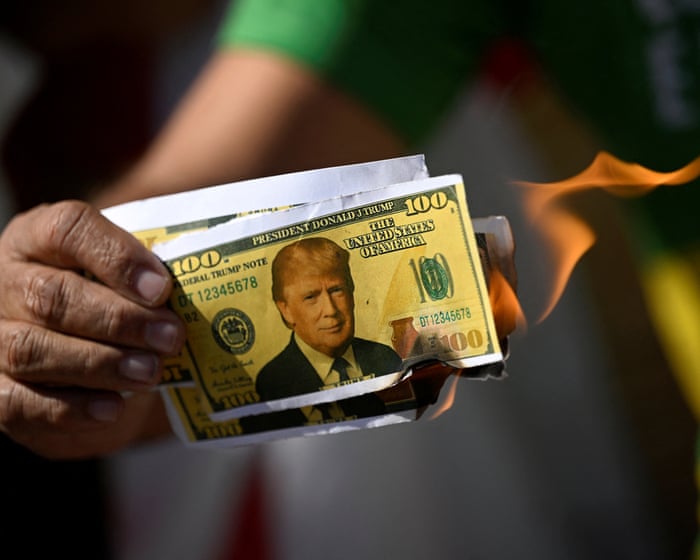Video and photos published in the Italian press appear to show, for the first time, a militia linked to the Libyan government taking part in smuggling people across the Mediterranean.
The footage and images, shared with the Guardian, were captured by a journalist from the Italian newspaper La Repubblica who was on board a rescue boat run by the NGO Mediterranea Saving Humans. One set of images shows Kurdish refugees in the water near the rescue vessel. Witnesses said the refugees had been kicked off a boat into the sea after telling the NGO they had been taken from a Libyan detention center by the militia.
The NGO has sent the images and a detailed report of the incident to prosecutors in Trapani, Sicily, and to the International Criminal Court.
In a statement, Mediterranea said, “This time there is video and photo evidence that can’t be ignored: the Libyan traffickers who violently threw ten young refugees into the open sea, right in front of our rescue boat, after holding them in detention camps, are part of Tripoli’s official military structure.” The group uses a broad definition of trafficking that includes any form of exploitation or coercion along smuggling routes. “We’ve always known this, but now we’ve filmed them, photographed them, and identified them. We know who they are.”
The first set of clips and photos, from August 18, shows men on Libyan patrol boats wearing balaclavas and uniforms with the insignia of the 80th Special Operations Battalion of the 111th Brigade—a militia led by Libya’s deputy defense minister, Abdul Salam Al-Zoubi.
A second set of footage, taken two nights later, shows Iraqi-Kurdish people in the water after witnesses on the NGO boat said they were thrown overboard. When rescuers shone a light on the boat as it turned away, it showed the same irregular paint pattern—black sides with a white hull—as the vessel seen on August 18.
Kurdish survivors told the NGO crew they had been taken from a Libyan detention center just hours earlier. They also said that four others who refused to go with the militia, fearing a trap, were killed.
Libya has become a major transit point in recent years for migrants escaping conflict and poverty in Africa and the Middle East. According to the International Organization for Migration, as of February 2025, around 867,055 people from 44 different nationalities were living in Libya.
In the latest deadly incident in the Mediterranean, the IOM reported that a boat carrying Sudanese refugees caught fire and sank off the coast of Tobruk in eastern Libya over the weekend, killing at least 50 people as it headed toward Greece.
Multiple aid agencies, including the United Nations, have reported for years that government-backed militias in Libya are involved in human rights abuses against migrants. These include running or supporting detention centers where people are extorted, tortured, and sexually enslaved, as well as kidnapping for ransom, working with the Libyan coastguard, and human trafficking.
Libyan militias have been patrolling the Mediterranean since the Tripoli government signed a deal with Italy in February 2017, authorizing them to intercept and forcibly return migrants.Italy has been working with Libya to reduce the number of migrants crossing the Mediterranean. The agreement, negotiated by former Italian Interior Minister Marco Minniti from the centre-left Democratic Party, involved Italy providing funding and equipment to Libya.
On September 4, Libya’s Defence Minister met with Italy’s current Interior Minister, Matteo Piantedosi, who praised the “fruitful cooperation” between the two countries.
However, Luca Casarini, co-founder of the migrant rescue group Mediterranea, told the Guardian that evidence from rescued migrants—including video, photos, and personal accounts—suggests that Italian funds are actually benefiting human traffickers.
The Guardian reached out to both the Italian Interior Ministry and Libya’s Defence Ministry for comment but has not received a response from either.
Frequently Asked Questions
Of course Here is a list of FAQs about videos reportedly showing statelinked Libyan militias involved in smuggling people across the Mediterranean designed to be clear and helpful
General Definition Questions
1 What is this story about
This story is about videos that appear to show armed groups in Libya which are connected to the countrys official authorities actively participating in or facilitating the smuggling of migrants across the Mediterranean Sea to Europe
2 Who are the statelinked Libyan militias
These are armed groups that are not part of the official national army but have been integrated into state structures They often receive government funding and operate with official approval sometimes providing security but in this case they are allegedly involved in criminal smuggling operations
3 Why is the Mediterranean route so dangerous
The crossing is made on overcrowded unseaworthy rubber dinghies or wooden boats supplied by smugglers The journey is long and the sea conditions can be treacherous leading to a high risk of capsizing drowning dehydration and exposure
Questions About the Situation Implications
4 Why would militias work with smugglers
It is primarily for profit Smuggling migrants is a multimillion dollar business For militias it provides a lucrative source of income to fund their operations and pay their fighters especially in a country with a weak economy and ongoing political instability
5 Isnt the Libyan Coast Guard supposed to stop this
Yes the EUbacked Libyan Coast Guard is tasked with intercepting migrant boats and returning them to Libya However these reports suggest that some elements within the states own network might be involved in the very activity they are supposed to prevent creating a major conflict of interest
6 What happens to migrants when they are returned to Libya
Migrants are typically taken to detention centers which have been widely condemned by human rights organizations Reports from these centers describe horrific conditions including overcrowding malnutrition torture forced labor and abuse
7 How does this affect European migration policy
It creates a significant dilemma European policies often rely on Libyan authorities to manage migration flows and prevent departures If those same authorities are involved in smuggling it undermines the entire strategy and raises serious ethical questions about the partnership
Practical ActionOriented Questions
8 Where can I see these videos
The videos have been published




